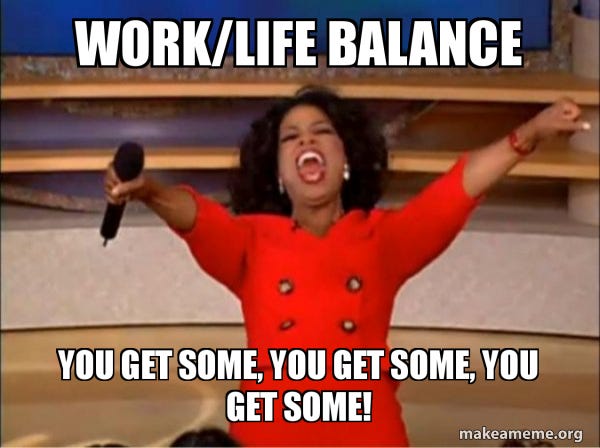The types of companies you can work for and what they do for your career
Six most common company archetypes.
Sometimes, you just need a paycheck, so you take whatever job is available. But other times, you have the privilege of making a more intentional choice about where to work. In fact, as we progress in our careers and demand for our expertise begins to exceed the supply, we usually earn the right to be more selective. Yet, many people continue jumping between companies without much thought — chasing a fancy title or a raise.
If you have the opportunity to be more intentional about your next move, this post will break down different company archetypes and what each one can do for your career.
Six most common archetypes
I see the following as the most common company archetypes:
Let’s go through each one.
Archetype 1: Unicorns
These companies are fast growing scaleups. They are typically <200 employees large, generate $50-100M in revenue, and are growing at a blistering ~100% year-over-year. Think Miro, Figma, and Slack in their early days or Clay now. Joining one of these is like strapping yourself to a rocket — thrilling, high-speed, and terrifying. Burnout is almost guaranteed, but the experience will be one you talk about for the rest of your career.
You won’t necessarily learn much in the traditional sense because everything is moving so fast and up to the right. Mistakes often go unnoticed as long as the growth keeps compounding. If you flourish in chaos, can handle being overwhelmed, and enjoy wearing multiple hats, this is the place for you.
Work Environment: Most of your time will be spent figuring out why the business is already growing and removing obstacles in its way. Hiring aggressively, putting processes in place (without killing the momentum), and constantly re-adjusting to new realities.
Challenges: One of the toughest aspects? People get outgrown fast. Not everyone can evolve and adapt quickly enough to keep their jobs. A director at a $50M company is very different from a director at a $150M company — and in these businesses, that transition could happen in just a year.
Career Impact: If you survive, having “founding team member at a unicorn” on your resume opens a lot of doors.
Your Seat at the Table: Medium-sized. You’ll have visibility into strategic decisions, but good luck influencing them unless you’re in the core leadership circle.
I’ve experienced this environment at Miro. My workdays started at 5 AM and never really ended — it was an “always-on” role. Things were happening at an astronomical speed, and all I was trying to do was keep up. I dreamt about work and often woke up at 3 AM just to finish sending Slack messages that were stressing me out. The ride was exhilarating but mentally and physically taxing. I wouldn’t trade my time there for anything, but I’m not sure I have the energy to do it again.
Archetype 2: Tankers
These are your Googles, Apples, and Microsofts. 100,000+ employees, billions in revenue, and growing at a steady 5-15% annually. These companies run like well-oiled machines — meaning every role is hyper-specialized and your job is to stay in your lane.
Work Environment: Here, you’re part of a massive ship that’s already on its predetermined course. The politics and tech debt are legendary and progress happens at a glacial pace. On the plus side, you get to see what true scale looks like.
Challenges: It’s slow and steady for a reason. Very measured decision-making and lots of “work about work” can feel like death by a thousand cuts.
Career Impact: These companies are great places to start your career, offering plenty of training resources and oversight. Career growth is doable, but outcomes are not valued as much as mastering the art of managing up and navigating internal bureaucracy.
Your Seat at the Table: Don’t expect to drive major change — your seat at the table is tiny, possibly in a completely different building.
It’s worth mentioning that these companies pay exceptionally well. If financial stability and benefits are your priorities, these are the places to be.
Archetype 3: Declining Giants
These are the once-mighty corporations that are now struggling to grow. Think IBMs and Yahoo’s of the world. They have thousands of employees and have only one goal: need to re-accelerate growth. The problem? Years of bureaucracy, aging infrastructure, and an ingrained resistance to change. But this is where you can truly sharpen your ability to execute, adapt, and lead through uncertainty.
Work Environment: Full of reorgs, strategy pivots, and leadership shake-ups. If you like change, buckle up — these places never stop changing.
Challenges: The challenge here is execution: every mistake (and win) is highly visible. There’s no coasting. You either deliver results or you don’t last.
Career Impact: Career opportunities are big since turnover is high. If you play your cards right, you can climb the ladder quickly. But mentally, this is a different game. Whereas a unicorn changes to support massive success, a declining giant changes out of desperation. Playing to win versus playing not to lose are two different games.
Your Seat at the Table: Surprisingly large — because anyone who can actually drive results is desperately needed.
Archetype 4: Survival mode
These are the earliest-stage companies still searching for product-market fit. Think pre-Series A startups with 10-50 employees, maybe a million in revenue (if that), and a whole lot of uncertainty.
Work Environment: These are arguably the most stressful companies to work at. Every decision could be life or death for the business. You’re expected to do everything because no one else is around to do it. Chaos is the norm and structure is a distant dream but autonomy is high.
Challenges: The biggest risk? The company might not make it. Many don’t.
Career Impact: If you have no problem with ambiguity, enjoy building things from scratch, and want to develop a ridiculously broad skillset, this can be a career-defining experience. I would not recommend these for anyone early in their career — there’s no mentorship or structured learning environment here.
Your Seat at the Table: Massive. In fact, you might be the one building the table. However, your comp is non-existent and likely loaded with equity that may or may not materialize into anything meaningful.
Archetype 5: Lifestyle Boats
These are often founder-led, bootstrapped, profitable, and optimized for sustainable growth. Think Basecamp or Mailchimp before the acquisition. These companies aren’t in a rush to scale at all costs.
Work Environment: Expect to wear multiple hats, but in a far more controlled and less chaotic environment than a unicorn or early-stage startup.
Challenges: Work-life balance is often better, but career acceleration can be slower since these companies don’t have the same “exit at all costs” mentality.
Career Impact: You get a first-hand look at how sustainable businesses operate. Mentorship and strong work relationships within your team and with business partners might be more inherent.
Your Seat at the Table: Medium-sized, but heavily dependent on company culture. Some founders keep things tight, while others encourage collaboration across teams.
To me, this was SurveyMonkey during the seven years I was there. It had a leadership team with multiple success stories under its belt, a willingness to invest in the team, and a capability to drive sustainable growth without any VC pressure. There was undeniable pressure to deliver results, but it came with plenty of support and reasonable timelines. These environments are fantastic places for people early in their careers.
Archetype 6: Social Good Seekers
These are companies where impact is prioritized over revenue. Think Patagonia or smaller nonprofits focused on climate change, education, or social justice. If making a difference is your primary motivator, these environments can be incredibly fulfilling.
Work Environment: Resources are often scarce and scaling impact without scaling funding is an ongoing struggle.
Challenges: Salaries may not be as competitive as in the private sector, but job satisfaction can be high if you believe in the mission.
Career Impact: The opportunity to make tangible contributions to causes you care about can be deeply satisfying. You’ll learn how to be strategic and “do more with less” — which is true of almost all companies anyway — but it’ll more personally align with your values and passions.
Your Seat at the Table: Often larger than expected, especially if the organization is smaller. You may have a say in big decisions, but expect constraints around execution due to funding limitations.
Evaluating Company Archetypes
To understand which archetype a company falls into, ask the following questions:
How many employees does the company have? (This one is easy.)
What has been the year-over-year revenue growth for the past three years? Private companies might be cagey about this, but if they don’t share it after you sign NDA, that’s a red flag.
How much runway does the company have? Everyone can say they’re on “the path to profitability,” but find out how long they have before they need to raise another round to sustain operations. You don’t need exact financial numbers, but try to get a ballpark estimate (months, quarters, or years).
Know Thyself
There’s no denying it — the market is rough right now. But at the end of the day, you still need to be clear on what you want and which company archetype will be the best fit. Or at the very least, go in with a clear understanding of what to expect so you can set realistic expectations. Here are some key questions to ask yourself:
How tolerant am I of change? If you prefer a steady pace with little change, lifestyle companies or slow and steady tankers might be ideal. Scale ups or companies in transition (unicorns or declining giants) undergo TONS of changes.
How much pressure can I handle? More specifically, how much *negative pressure* can you take? Think incredibly tight deadlines, lots of thrashing, less work-life balance. This isn’t about questioning your ability to “handle your sh*t” but recognizing that companies on a downward trend or in tough industries may not align with what you’re looking for at the moment (and there are a lot of them out there).
Are clear roles and responsibilities important to me? The less established a company, the less clarity you’ll have around roles and responsibilities. For some, this ambiguity is exciting. For others, it might not be worth the added stress.
What’s my financial priority? Yes, it can just be about the money — depending on your personal circumstances and phase of life. If you need immediate financial security, you should probably skip the startup offering you the potential of a higher payout (read: equity) instead of a higher base salary.
Final Thoughts
Choosing the right company archetype depends on your risk tolerance, career goals, and appetite for chaos. Some people thrive in fast-growing scaleups, while others prefer the stability of an established giant. No one path is better than the other — it’s all about what you want out of your career.
But one thing is certain: knowing what you’re signing up for is half the battle.
Edited with the help of Melissa Halim.






One important thing to consider within this framework is where you are in your career.
It was incredibly frustrating working for FAANG and a unicorn as a recent grad - I had zero seat at the table and it was maddening how little progress was made.
When I moved to smaller startups, I was able to join as a senior leader with agency. Even though we faced the fear of running out of money and layoffs and tons of pressure to grow with limited resources, it ended up being far less stressful because of that agency.
Absolutely love this post, having a dilemma of pivoting from a tanker to an early stage pre-series A startup early in my career (2 years of work exp) this post gave me much more clarity on making my decision. Thanks!